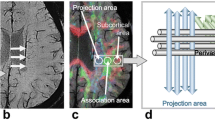Abstract
We investigated the isotropic diffusion coefficient (D’) and fractional anisotropy (FA) in white matter (WM) during brain development, using an optimised diffusion-tensor imaging (DTI) method with whole brain coverage in a clinically acceptable time. We images 52 children with no evident neurological abnormality (30 boys, 22 girls aged 1 day–16 years) using high-angle DTI with optimised temporal gradient performance. D’ and FA were calculated in 10 regions of interest in white matter. We saw that the age-related reduction in D’ and increase in FA follow a mono- or biexponential model in white matter, probably depending on the compactness and myelination rate of the fibre tracts. In contrast to other areas, in which adult values were reached during the third year, there is a trend to continuous increase in FA in all deep white-matter areas, suggesting continuing maturation and organisation of deep tracts not detected on conventional MRI.



Similar content being viewed by others
References:
Basser PJ, Mattiello J, LeBihan D (1994) MR diffusion tensor spectroscopy and imaging. Biophys J 66: 259–267
Mori S, van Zijl PC (1995) Diffusion weighting by the trace of the diffusion tensor within a single scan. Magn Reson Med 33: 41–52
Baratti C, Barnett AS, Pierpaoli C (1999) Comparative MR imaging study of brain maturation in kittens with T1, T2, and the trace of the diffusion tensor. Radiology 210: 133–142
Huppi PS, Maier SE, Peled S, et al (1998) Microstructural development of human newborn cerebral white matter assessed in vivo by diffusion tensor magnetic resonance imaging. Pediatr Res 44: 584–590
Klingberg T, Vaidya CJ, Gabrieli JD, et al (1999) Myelination and organization of the frontal white matter in children: a diffusion tensor MRI study. Neuroreport 10: 2817–2821
Pierpaoli C, Basser PJ (1996) Toward a quantitative assessment of diffusion anisotropy. Magn Reson Med 36: 893–906
Pierpaoli C, Jezzard P, Basser PJ, et al (1996) Diffusion tensor MR imaging of the human brain. Radiology 201: 637–648
Nomura Y, Sakuma H, Takeda K, et al (1994) Diffusional anisotropy of the human brain assessed with diffusion-weighted MR: relation with normal brain development and aging. AJNR 15: 231–238
Morriss MC, Zimmerman RA, Bilaniuk LT, et al (1999) Changes in brain water diffusion during childhood. Neuroradiology 41: 929–934
Prayer D, Barkovich AJ, Kirschner DA, et al (2001) Visualization of nonstructural changes in early white matter development on diffusion-weighted MR images: evidence supporting premyelination anisotropy. AJNR 22: 1572–1576
Wimberger DM, Roberts TP, Barkovich AJ, et al (1995) Identification of “premyelination” by diffusion-weighted MRI. J Comput Assist Tomogr 19: 28–33
Barkovich AJ (2000) Concepts of myelin and myelination in neuroradiology. AJNR 21: 1099–1109
Neil JJ, Shiran SI, McKinstry RC, et al (1998) Normal brain in human newborns: apparent diffusion coefficient and diffusion anisotropy measured by using diffusion tensor MR imaging. Radiology 209: 57–66
Basser PJ, Pierpaoli C (1996) Microstructural and physiological features of tissues elucidated by quantitative-diffusion-tensor MRI. J Magn Reson B 111: 209–219
Conturo TE, Lori NF, Cull TS, et al (1999) Tracking neuronal fiber pathways in the living human brain. Proc Natl Acad Sci USA 96: 10422–10427
Basser PJ, Pajevic S, Pierpaoli C, et al (2000) In vivo fiber tractography using DT-MRI data. Magn Reson Med 44: 625–632
Jones DK, Horsfield MA, Simmons A (1999) Optimal strategies for measuring diffusion in anisotropic systems by magnetic resonance imaging. Magn Reson Med 42: 515–525
Bastin ME, Armitage PA (2000) On the use of water phantom images to calibrate and correct eddy current induced artefacts in MR diffusion tensor imaging. Magn Reson Imaging 18: 681–687
Simpson JH CH (1958) Diffusion and nuclear spin relaxation in water. Phys Rev 111: 1201–1202
Mukherjee P, Miller JH, Shimony JS, et al (2001) Normal brain maturation during childhood: developmental trends characterized with diffusion-tensor MR imaging. Radiology 221: 349–358
Jezzard P, Barnett AS, Pierpaoli C (1998) Characterization of and correction for eddy current artifacts in echo planar diffusion imaging. Magn Reson Med 39: 801–812
Haselgrove JC, Moore JR (1996) Correction for distortion of echo-planar images used to calculate the apparent diffusion coefficient. Magn Reson Med 36: 960–964
Papadakis NG, Xing D, Houston GC, et al (1999) A study of rotationally invariant and symmetric indices of diffusion anisotropy. Magn Reson Imaging 17: 881–892
Engelbrecht V, Scherer A, Rassek M, et al (2002) Diffusion-weighted MR imaging in the brain in children: findings in the normal brain and in the brain with white matter diseases. Radiology 222: 410–418
Tanner SF, Ramenghi LA, Ridgway JP, et al (2000) Quantitative comparison of intrabrain diffusion in adults and preterm and term neonates and infants. Am J Roentgenol 174: 1643–1649
Shimony JS, McKinstry RC, Akbudak E, et al (1999) Quantitative diffusion-tensor anisotropy brain MR imaging: normative human data and anatomic analysis. Radiology 212: 770–784
Cowley AR (1983) The Dyke Award. Influence of fiber tracts on the CT appearance of cerebral edema: anatomic-pathologic correlation. AJNR 4: 915–925
Author information
Authors and Affiliations
Corresponding author
Rights and permissions
About this article
Cite this article
Schneider, J.F.L., Il’yasov, K.A., Hennig, J. et al. Fast quantitative diffusion-tensor imaging of cerebral white matter from the neonatal period to adolescence. Neuroradiology 46, 258–266 (2004). https://doi.org/10.1007/s00234-003-1154-2
Received:
Accepted:
Published:
Issue Date:
DOI: https://doi.org/10.1007/s00234-003-1154-2




